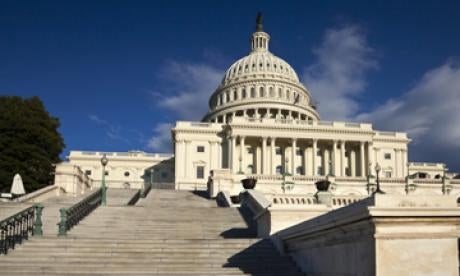Legislative Activity
Lawmakers Call for Sequestration Repeal
Rep. Mike Turner (R-OH), a senior member of the House Armed Services Committee, has enlisted other lawmakers in urging House Speaker Paul Ryan (R-WI) to repeal Pentagon spending limits mandated by the 2011 Budget Control Act. Twenty-four Republicans have signed on to the letter, which seeks a floor vote to repeal sequestration and argues the cost-cutting measure diminishes military readiness and the ability to effectively deter adversaries. The letter also notes that a majority of the 115th Congress has never cast a vote on sequestration and should have the opportunity to voice their opposition.
This Week’s Hearings:
-
On Wednesday, February 1, the Senate Homeland Security and Governmental Affairs Committee is scheduled to hold a business meeting.
-
On Wednesday, February 1, the Senate Homeland Security and Governmental Affairs Committee has scheduled a hearing titled “Fencing Along the Southwest Border.”
-
On Thursday, February 2, the House Armed Services Committee has scheduled a hearing to consider the Committee Oversight Plan for the 115th Congress.
Executive Branch Activity
New Executive Order Suspends U.S. Refugee Program, Visa Issuance
On Friday, 27 January, President Donald Trump signed an Executive Order (EO) titled “Protecting the Nation from Foreign Terrorist Entry into the United States.” The EO:
-
Suspends the issuance of visas and admission into the United States for foreign nationals from countries of “particular concern,” including individuals already holding valid visas and green cards. Although initially barred, on January 29, green card holders (as opposed to nonimmigrant visa holders) were officially deemed to fall outside the EO and are now permitted entry.
-
Temporarily suspends the entry of individuals from Iraq, Syria, Iran, Sudan, Libya, Somalia and Yemen for 90 days.
-
Directs a review of the information required to vet individuals attempting to enter the United States from certain countries to adequately ensure such individuals are not a “security or public safety threat.”
-
Directs the development of a list of countries for which the entry of foreign nationals into the United States should be temporarily prohibited based on a lack of information impacting adequate vetting of individuals attempting to enter the United States from those countries.
-
Suspends the U.S. Refugee Admissions Program (USRAP) for 120 days and directs a review of the USRAP application process to determine what additional vetting procedures are required to ensure refugees “do not pose a threat to the security or welfare of the United States.”
-
Prohibits the admission of Syrian refugees indefinitely, deeming such admission “detrimental” to the United States.
-
Lowers the total number of refugees allowed to enter the United States from 110,000 to 50,000 for Fiscal Year 2017.
-
Suspends the Visa Waiver Interview Program and requires all individuals seeking a nonimmigrant visa to undergo an in-person interview.
-
Directs the collection of information regarding the number of foreign nationals who have been “radicalized” in the United States and engaged in terrorism-related activities.
Notably, the final EO removed mention of a plan to create “safe zones” within and near Syria that had been included in a previously leaked draft.
The EO was met with swift opposition from some lawmakers, a number of human rights organizations, and the U.S. business community. Critics noted the President’s action seemed to have been released with little input from or guidance for the agencies tasked with its implementation, as individuals in transit with valid documentation were detained and removed upon arriving at U.S. airports. Implementation has varied across ports of entry.
In one of several preliminary challenges across the country, a federal judge in New York issued a temporary stay to block the deportation of refugees and visa holders already in the U.S. or in transit pending a formal hearing. In a statement responding to the backlash, President Trump defended the actions, adding “America is a proud nation of immigrants and we will continue to show compassion to those fleeing oppression, but we will do so while protecting our own citizens and border.”
Additional Executive Orders Address Border Immigration Concerns, Sanctuary Cities
On Wednesday, January 25, President Trump signed two EOs related to United States-Mexico border and so-called “sanctuary cities,” or jurisdictions that limit local law enforcement’s role in enforcing federal immigration laws, particularly as it relates to the identification and removal of undocumented immigrants.
The EO “Enhancing Public Safety in the Interior of the United States” is designed to “ensure the public safety of the American people” and “that our Nation’s immigration laws are faithfully executed” under the Immigration and Nationality Act. The EO argues that many undocumented immigrants pose a threat to U.S. national security and public safety and claims sanctuary jurisdictions have caused “immeasurable harm to the American people and to the very fabric of our Republic.”
The EO prioritizes the removal of undocumented immigrants who have been convicted of, charged with, or committed criminal offenses, regardless of whether the criminal proceedings have concluded. Additionally, the EO mandates the prioritization of individuals who have “engaged in fraud,” abused public benefits, remained in the country following their legal obligation to depart the United States or “otherwise pose a risk to public safety or national security.”
The order defines sanctuary jurisdictions as those in “willful” violation of 8 U.S.C. § 1373, which addresses the sharing of immigration information between local law enforcement and the federal government. The EO grants broad authority to the Secretary of Homeland Security (DHS Secretary) to designate sanctuary jurisdictions and directs the Attorney General to ensure all jurisdictions considered noncompliant with Sec. 1373 are ineligible to receive many forms of federal grants.
Notably, the EO also terminates the U.S. Immigration and Customs Enforcement’s (ICE) Priority Enforcement Program (PEP), instituted by the Obama Administration in 2014. The EO calls for the reinstatement of the Secure Communities Program, piloted under the Bush Administration in 2008, which “uses an already-existing federal information-sharing partnership to identify and remove aliens who pose a threat to public safety.”
Several immigration advocates and municipal governments have released statements defending sanctuary policies and pledging to fight the EO. New York City Mayor Bill de Blasio argued the order would be “very destructive” for New York and would “undermine law enforcement’s ability to protect” the city. Legal experts have reportedly been discussing grounds for litigation, arguing the EO would coerce jurisdictions to enforce federal immigration law without consent and improperly restrict federal grants without a connection to their purpose.
The second EO, titled “Border Security and Immigration Enforcement Improvements,” calls border security critically important to national security and “aliens who illegally enter” the United States “a significant threat to national security and public safety.”
The EO directs the DHS Secretary to construct a physical wall along the southern border and determine long- and short- term funding options for the project. It also directs the DHS Secretary to use all available resources to establish or control detention facilities near the U.S.-Mexico border and assign asylum officers and immigration judges to those detention facilities.
Additionally, the EO directs the DHS Secretary to issue new policy guidance relating to the “consistent use of lawful detention authority” and terminating the “catch and release” policy. It also directs the hiring of 5,000 border patrol agents and calls for ending the “abuse of parole and asylum provisions that are currently used to prevent the lawful removal of removable aliens.”
President Trump Visits Pentagon, Unveils Memorandum on “Rebuilding the U.S. Armed Forces”
President Trump visited the Pentagon for the first time as Commander-in-Chief on Friday, January 27. Following meetings with senior defense officials, the President signed a memorandum titled “Rebuilding the U.S. Armed Forces.” The final text released by the White House calls for a review of the military’s readiness and directs the Pentagon to work with the Office of Management and Budget to craft a defense supplemental for the current fiscal year, as well as a budget plan for Fiscal Year 2018. The President’s action marks the first formal step towards undertaking an expansive military build-up, one of his key campaign promises. However, any plans to invest in a bigger military will require Congressional backing.
National Security Memorandum Reorganizes National Security and Homeland Security Councils
On Saturday, January 28, President Trump issued a memorandum reorganizing national security policy development and decision-making within the White House. The memorandum sets out the senior Executive Branch officials who will participate in meetings of the National Security Council and Homeland Security Councils, chaired by the National Security Advisor and the Homeland Security Advisor, respectively.
The memorandum was met with some criticism, as national security experts noted that the memorandum directs Assistant to the President and Chief Strategist Steve Bannon to participate in meetings of the Principals Committee, the Cabinet-level interagency body responsible for considering national security matters. In contrast, the memorandum establishes that the Director of National Intelligence and the Chairman of the Joint Chiefs of Staff are to only attend those Principal Committee meetings “where issues pertaining to their responsibilities and expertise are to be discussed.”
Pooja Virkar is co-author of this article.







 i
i


